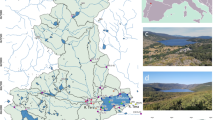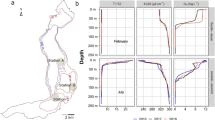Abstract
This study focused on unraveling the natural mechanism for the frequent shifts in alternative regimes in pristine shallow lakes of the Boreal Plains, Alberta, Canada. The lakes tend to be clear and dominated by submerged aquatic vegetation (SAV) or turbid and dominated by phytoplankton. We report on the inter-annual response of 23 lakes from 2001 to 2007. We explore the effect of fluctuations in annual precipitation on the lake response including water depth, total phosphorus (TP) concentration, turbidity, phytoplankton biomass, SAV biomass, and the proportion of clear and turbid lakes. The regime switches appear driven by the transient dynamics of phytoplankton, and dilution of nutrients, phytoplankton biomass, and turbidity during wet years, and evapoconcentration during dry years. Increased precipitation was correlated with decreased phytoplankton biomass, TP concentration, chloride concentration, and turbidity. In 2005, the wettest year, no phytoplankton-dominated lakes were observed. During the driest year (2002), the phytoplankton-dominant regime (>18 μg chl-a L−1) occurred in 22% of lakes, which was higher than the study period average. SAV biomass was not directly affected by precipitation, but was negatively associated with phytoplankton biomass and positively associated with the previous year’s SAV growth. SAV biomass was carried over from year-to-year, and the occurrence of SAV-dominated (>25% cover) lakes was significantly higher in 2007 (90%) following 3 years of high precipitation levels.




Similar content being viewed by others
References
Amemiya T, Enomoto T, Rossberg AG, Yamamoto T, Inamori Y, Itoh K. 2007. Stability and dynamical behavior in a lake-model and implications for regime shifts in real lakes. Ecol Model 206:54–62.
Anderson DR. 2008. Model based inference in the Life Sciences: a primer on evidence. New York: Springer.
Barko JW, James WF. 1998. Effects of submerged aquatic macrophytes on nutrient dynamics, sedimentation, and resuspension. In: Jeppesen E, Sondergaard M, Sondergaard MO, Christoffersen K, Eds. The structuring role of submerged macrophytes in lakes. New York: Springer. p 197–226.
Bayley S, Prather C. 2003. Do wetland lakes exhibit alternative stable states? Submersed aquatic vegetation and chlorophyll in western boreal shallow lakes. Limnol Oceanogr 48:2335–45.
Bayley SE, Creed IF, Sass GZ, Wong AS. 2007. Frequent regime shifts in trophic states in shallow lakes on the Boreal Plain: alternative “unstable” states? Limnol Oceanogr 52:2002–12.
Bergmann M, Peters RH. 1980. Simple reflectance method for the measurement of particulate pigment in lake water and its application to phosphorus–chlorophyll–seston relationships. Can J Fish Aquat Sci 37:111–14.
Blindow I, Andersson G, Hargeby A, Johansson S. 1993. Long-term pattern of alternative stable states in two shallow eutrophic lakes. Freshw Biol 30:159–67.
Carpenter SR, Lodge DM. 1986. Effects of submersed macrophytes on ecosystem processes. Aquat Bot 26:341–70.
Devito KJ, Creed IF, Rothwell RL, Prepas EE. 2000. Landscape controls on phosphorus loading to boreal lakes: implications for the potential impacts of forest harvesting. Can J Fish Aquat Sci 57:1977–84.
Devito K, Creed I, Fraser C. 2005a. Controls on runoff from a partially harvested aspen-forested headwater catchment, Boreal Plain, Canada. Hydrol Process 19:3–25.
Devito K, Creed I, Gan T, Mendoza C, Petrone R, Silins U, Smerdon B. 2005b. A framework for broad-scale classification of hydrologic response units on the Boreal Plain: is topography the last thing to consider? RID C-5422-2011. Hydrol Process 19:1705–14.
Eminson D, Moss B. 1980. The composition and ecology of periphyton communities in freshwaters. 1. The influence of host type and external environment on community composition. Br Phycol J 15:429–46.
Engel S, Nichols SA. 1994. Aquatic macrophyte growth in a turbid windswept lake. J Freshw Ecol 9:97–109.
Environment Canada. 2010. National climate data and information archive. http://www.climate.weatheroffice.gc.ca/climateData/. Accessed 16 July 2010.
Ferone JM, Devito K. 2001. Landscape controls of hydrologic function and phosphorus dynamics in two pond–wetland complexes on the mixedwood boreal plain. Thesis, University of Alberta, Edmonton. p 159.
Ferone JM, Devito KJ. 2004. Shallow groundwater-surface water interactions in pond-peatland complexes along a Boreal Plains topographic gradient. J Hydrol 292:75–95.
Hamilton WN, Price MC, Langenberg CW. 1999. Geological map of Alberta [map 236]. 1:1,000,000. Edmonton (AB): Alberta Geological Survey.
Hargeby A, Blindow I, Andersson G. 2007. Long-term patterns of shifts between clear and turbid states in Lake Krankesjon and Lake Takern. Ecosystems 10:28–35.
Hastings A. 2004. Transients: the key to long-term ecological understanding? Trends Ecol Evol 19:39–45.
Hornung JP, Foote AL. 2006. Aquatic invertebrate responses to fish presence and vegetation complexity in Western Boreal wetlands, with implications for waterbird productivity. Wetlands 26:1–12.
Jeppesen E, Jensen JP, Kristensen P, Sondergaard M, Mortensen E, Sortkjaer O, Olrik K. 1990. Fish manipulation as a lake restoration tool in shallow, eutrophic, temperate lakes. 2. Threshold levels, long-term stability and conclusions. Hydrobiologia 200:219–27.
Jeppesen E, Lauridsen TL, Kairesalo T, Perrow MR. 1998a. Impact of submerged macrophytes on fish–zooplankton interactions in lakes. In: Jeppesen E, Sondergaard M, Christoffersen K, Eds. Structuring role of submerged macrophytes in lakes, Vol. 131. New York: Springer. p 91–114.
Jeppesen E, Sondergaard M, Sondergaard M, Christoffersen K. 1998b. The structuring role of submerged macrophytes in lakes. New York: Springer.
Jeppesen E, Jensen JP, Søndergaard M, Lauridsen T. 1999. Trophic dynamics in turbid and clearwater lakes with special emphasis on the role of zooplankton for water clarity. Hydrobiologia 408/409:217–31.
Kosten S, Kamarainen A, Jeppesen E, van Nes E, Peeters E, Mazzeo N, Sass L, Hauxwell J, Hansel-Welch N, Lauridsen T, Sondergaard M, Bachmann R, Lacerot G, Scheffer M. 2009. Climate-related differences in the dominance of submerged macrophytes in shallow lakes. Glob Chang Biol 15:2503–17.
Lauridsen TL, Pedersen LJ, Jeppesen E, Sondergaard M. 1996. The importance of macrophyte bed size for cladoceran composition and horizontal migration in a shallow lake. J Plankton Res 18:2283–94.
Loverde-Oliveira S, Huszar V, Mazzeo N, Scheffer M. 2009. Hydrology-driven regime shifts in a shallow tropical lake. Ecosystems 12:807–19.
Mazerolle MJ. 2011. AICcmodavg: model selection and multimodel inference based on (Q)AIC(c). R package version 1.28. http://cran.r-project.org/package=AICcmodavg. Accessed 21 Feb 2011.
McGowan S, Leavitt PR, Hall RI, Wolfe BB, Edwards TWD, Karst-Riddoch T, Vardy SR. 2011. Interdecal declines in flood frequency increase primary production in lakes of a northern river delta. Glob Chang Biol 17:1212–24.
Moodie GEE. 1986. The population biology of Culaea inconstans, the brook stickleback, in a small prairie lake. Can J Zool 64:1709–17.
Moss B. 2010. Ecology of freshwaters: a view for the twenty-first century. 4th edn. Hoboken (NJ): Wiley-Blackwell.
Nakagawa S, Schielzeth H. 2013. A general and simple method for obtaining R 2 from generalized linear mixed-effects models. Methods Ecol Evol 4:133–42.
Noges T, Noges P. 1999. The effect of extreme water level decrease on hydrochemistry and phytoplankton in a shallow eutrophic lake. Hydrobiologia 408:277–83.
Norlin J, Bayley S, Ross L. 2005. Submerged macrophytes, zooplankton and the predominance of low- over high-chlorophyll states in western boreal, shallow-water wetlands. Freshw Biol 50:868–81.
Pawlowicz JG, Fenton MM. 2002. Drift thickness of the Peerless Lake map area (NTS 84B). [map 253]. 1:250,000. Edmonton (AB): Alberta Geological Survey.
Phillips GL, Eminson D, Moss B. 1978. Mechanism to account for macrophyte decline in progressively eutrophicated freshwaters. Aquat Bot 4:103–26.
Pinheiro JC, Bates DM. 2000. Mixed-effects models in S and S-PLUS. New York: Springer.
Pinheiro J, Bates D, DebRoy S, Sarkar D, R Development Core Team. 2012. nlme: linear and nonlinear mixed effects models. R package version 3.1-105.
Prepas E. 1978. Sugar-frosted Daphnia—an improved fixation technique for Cladocera. Limnol Oceanogr 23:557–9.
R Development Core Team. 2010. R: a language and environment for statistical computing. http://www.r-project.org. Accessed 31 May 2010.
Redding TE, Devito KJ. 2008. Lateral flow thresholds for aspen forested hillslopes on the Western Boreal Plain, Alberta, Canada. Hydrol Process 22:4287–300.
Redding T, Devito K. 2011. Aspect and soil textural controls on snowmelt runoff on forested Boreal Plain hillslopes. Hydrol Res 42:250–67.
Sand-Jensen K, Sondergaard M. 1981. Phytoplankton and epiphyte development and their shading effect on submerged macrophytes in lakes of different nutrient status. Internationale Revue der gesamten Hydrobiologie und Hydrographie 66:529–52.
Sass GZ, Creed IF, Bayley SE, Devito KJ. 2008. Interannual variability in trophic status of shallow lakes on the Boreal Plain: is there a climate signal? Water Resour Res 44:1–11.
Scheffer M. 1998. Ecology of shallow lakes. 1st edn. London: Chapman and Hall.
Scheffer M, Carpenter SR. 2003. Catastrophic regime shifts in ecosystems: linking theory to observation. Trends Ecol Evol 18:648–56.
Scheffer M, Hosper S, Meijer M, Moss B, Jeppsen E. 1993. Alternative equilibria in shallow lakes. Trends Ecol Evol 8:275–9.
Scheffer M, Carpenter S, Foley JA, Folke C, Walker B. 2001. Catastrophic shifts in ecosystems. Nature 413:591–6.
Schindler DW, Donahue WF. 2006. An impending water crisis in Canada’s western prairie provinces. Proc Natl Acad Sci USA 103:7210–16.
Schindler DW, Bayley SE, Parker BR, Beaty KG, Cruikshank DR, Fee EJ, Schindler EU, Stainton MP. 1996. The effects of climatic warming on the properties of boreal lakes and streams at the Experimental Lakes Area, northwestern Ontario. Limnol Oceanogr 41:1004–17.
Sokal MA, Hall RI, Wolfe BB. 2008. Relationships between hydrological and limnological conditions in lakes of the Slave River Delta (NWT, Canada) and quantification of their roles on sedimentary diatom assemblages. J Paleolimnol 39:533–50.
Swanson GA. 1978. A water column sampler for invertebrates in shallow wetlands. J Wildl Manag 42:670–2.
Taylor DJ, Hebert PDN, Colbourne JK. 1996. Phylogenetics and evolution of the Daphnia longispina group (Crustacea) based on 12S rDNA sequence and allozyme variation. Mol Phylogenet Evol 5:495–510.
Van Geest GJ, Roozen F, Coops H, Roijackers RMM, Buijse AD, Peeters E, Scheffer M. 2003. Vegetation abundance in lowland flood plain lakes determined by surface area, age and connectivity. Freshw Biol 48:440–54.
Van Geest G, Coops H, Scheffer M, van Nes E. 2007. Long transients near the ghost of a stable state in eutrophic shallow lakes with fluctuating water levels. Ecosystems 10:36–46.
Van Nes EH, Scheffer M, van den Berg MS, Coops H. 2002. Dominance of charophytes in eutrophic shallow lakes—when should we expect it to be an alternative stable state? Aquat Bot 72:275–96.
Wallsten M, Forsgren PO. 1989. The effects of increased water level on aquatic macrophytes. J Aquat Plant Manag 27:32–7.
Weisner SEB, Strand JA, Sandsten H. 1997. Mechanisms regulating abundance of submerged vegetation in shallow eutrophic lakes. Oecologia 109:592–9.
Wolfe BB, Karst-Riddoch TL, Hall RI, Edwards TWD, English MC, Palmini R, McGowan S, Leavitt PR, Vardy SR. 2007. Classification of hydrological regimes of northern floodplain basins (Peace-Athabasca Delta, Canada) from analysis of stable isotopes (delta O-18, delta H-2) and water chemistry. Hydrol Process 21:151–68.
Acknowledgments
Long-term ecological data was collected with assistance from Thorsten Hebben, Ivor Norlin, Joe Van Humbeck, Andre Asselin, Jean Arseneau, Jamie-Lynn Greter, Lavaya Bathini, Raven Beardy, Cory Kremer, and Randi Stead. Megan Robinson provided GIS analysis. Financial support to D. Cobbaert is gratefully received from the National Sciences and Engineering Research Council of Canada (NSERC), Alberta Conservation Association Biodiversity Fund, the Alberta Ingenuity Fund, the C-BAR program of the Circumpolar Institute, and Alberta Environment. Financial support from NSERC to S.E. Bayley is also appreciated. Dr. Wolf Mooij and three anonymous reviewers provided insightful feedback that improved the manuscript.
Author information
Authors and Affiliations
Corresponding author
Additional information
Author contributions
DC conceived the study, performed the research, analyzed data and wrote the paper. AW analyzed data and contributed to writing the paper. SEB conceived the study and contributed to writing the paper.
Rights and permissions
About this article
Cite this article
Cobbaert, D., Wong, A. & Bayley, S.E. Precipitation-Induced Alternative Regime Switches in Shallow Lakes of the Boreal Plains (Alberta, Canada). Ecosystems 17, 535–549 (2014). https://doi.org/10.1007/s10021-013-9741-5
Received:
Accepted:
Published:
Issue Date:
DOI: https://doi.org/10.1007/s10021-013-9741-5




